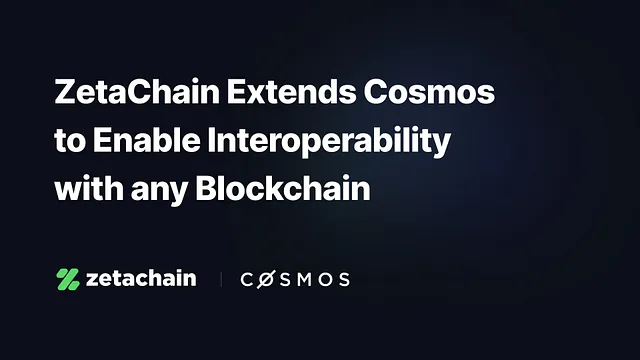ZetaChain Extends Cosmos IBC to Enable Blockchain Agnostic Interoperability
Mar 28, 2025
ZetaChain Team
Check out this blog post in español, 中文, 日本語, हिंदी, 한국인, tiếng-việt, and français
The next generation public computer will not be confined to a single blockchain. In the case of Cosmos, since its inception, its blockchain and community recognized the potential and need for a more connected blockchain ecosystem. Based on the Cosmos SDK, a thriving ecosystem of sovereign application-specific blockchains continues to emerge (dYdX v4, Osmosis, Juno, EVMOS, THORChain, etc.). Comparably, other projects exist as well such as Polkadot with its relay-chain/para-chains system. One important difference between the two is Polkadot’s shared security model versus Cosmos’ hub-router model.
In terms of vision and scope, we argue Cosmos offers a more state-of-the-art design — one that greatly inspired ZetaChain, a decentralized and transparent L1 blockchain. Zetachain strives to achieve complete interoperability with its built-in cross-chain smart contract platform and flexible programmability. In this post, we briefly explore Cosmos’ approach to blockchain interoperability with specific consideration of its Inter-Blockchain Communication (IBC) Protocol. Then, we discuss how ZetaChain extends the Cosmos IBC to enable full omnichain interoperability with any existing or legacy chain.
How does information go across blockchains?
Let’s review how information moves across blockchains while highlighting Cosmos’ approach where applicable. Assume someone (it could be an automatic agent) submits events on blockchain A to blockchain B, and blockchain B is supposed to do something about it. Fundamentally, the question is how does blockchain B know that this information is true on blockchain A? At a high-level, there are three ways:
Trustless: cross-chain scheme e.g. an atomic swap
Light Client Verification: blockchain B verifies the information (tx/event/state) of blockchain A with its integrated logic in a consensus rule or smart contract
Trusted 3rd Party: a trusted external entity verifies and forwards the information to blockchain B
Trustless
The first approach is trustless meaning there is no additional trusted entities needed other than the two involved chains: blockchain A and B. This is ideal; however, it is not generic. For example, so far, it seems the atomic swap is the only technique that works like this, and it’s far from supporting arbitrary cross-chain logic.
Light Client Verification
The second approach is also trustless and rather generic. This is the approach that Cosmos IBC takes. IBC is well integrated with the Cosmos SDK as a module, and any two chains with the Tendermint consensus engine that implement IBC functionality would be able to verify each other’s transactions just like a light client. Note, a light client only stores minimal data about a blockchain, relying on availability of the full blockchain data on other full nodes. In the case of Cosmos IBC, you can think of it as a light client embedded into the consensus rules. The apparent downside is that in order to use IBC, blockchains need to use its particular consensus engine (Tendermint) and implement IBC in its core. This means in practice, only Cosmos chains or new blockchains can integrate.
Trusted 3rd Party
The third trustful approach is even more general. It does not require the modification or accommodation from either blockchain A or B. It just needs a trusted third-party. It could be a centralized entity (like a centralized exchange, or Quant OverLedger), or a decentralized entity (a blockchain in the case of THORChain, or a set of validators like Wormhole).
ZetaChain’s Approach & Comparison with Cosmos
ZetaChain combines the Light Client Verification and Trusted 3rd Party approach to provide decentralized, secure, all-purpose cross-chain programmability. Specifically:
ZetaChain is a Proof-of-Stake (PoS) blockchain that relies on the same PoS mechanism to essentially “vote” to verify (or more accurately put, notarize) the cross-chain transactions, based on each observer’s independent full-node observations.
ZetaChain can also be considered a replicated state machine, which integrates light clients of all connected blockchains.
We believe ZetaChain’s approach combines the best of all approaches — decentralized, trustless, chain-agnostic, and generally programmable. For instance, PoS votes/notarization are resistant to extrinsic attacks targeted at light clients, but vulnerable to intrinsic attacks (1/3rd ZETA validator stake attacks). It’s for the most part slightly easier to attack light clients than full-nodes. On the other hand, the light client is resistant to intrinsic attacks, but vulnerable to extrinsic attacks aimed at fooling light clients of connected blockchains (Ethereum, Binance Smart Chain, Bitcoin, etc.). Combining notarization with light clients achieves maximum security. Due to the complexity of light clients in the state machine, ZetaChain will initially be based on PoS notarization. Then gradually over time, it will integrate the trustless light clients in its state machine.
Conclusion
In this post, we identify three ways information is passed across blockchains in the most recent context of cross-chain programmability. We review Cosmos’ analogous system for inter-blockchain connectivity (Cosmos IBC) and ZetaChain. Our analysis shows ZetaChain combines the best of all approaches such that it extends the functionality and security model of the Cosmos IBC protocol to enable full interoperability with any existing or legacy chain.
Join our community
A new wave of omnichain dApps powered by ZetaChain is coming. We invite you to join our Discord community and follow ZetaChain on Twitter @zetablockchain so you can partake in beta-testing this next generation of groundbreaking crypto products.
About ZetaChain
ZetaChain is the foundational layer to a multichain future. The novel blockchain enables multichain functionality without using bridges or wrapped tokens and the easy deployment of omnichain-dApps, or odApps. These applications can manage and connect data and value across all smart contract platforms as well as non-smart contract platforms like Bitcoin and Dogecoin.
